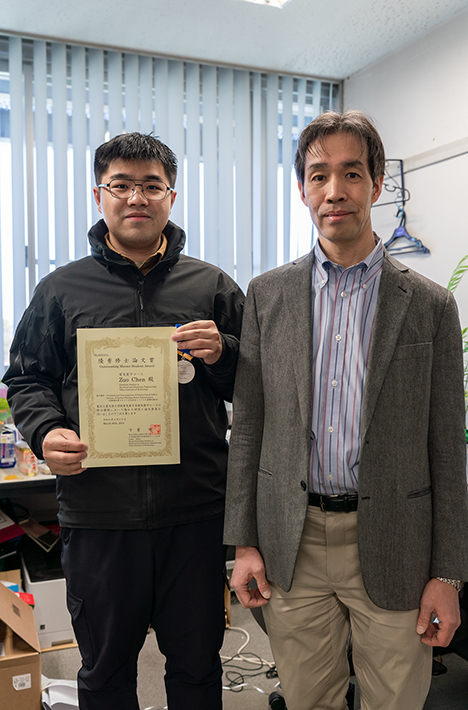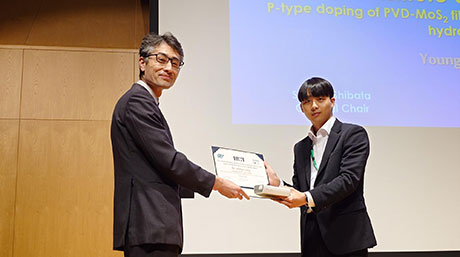Electrical and Electronic Engineering News
2023 Outstanding Master Student Award ― ZUO CHEN(Tomoyuki Miyamoto Lab.)
Fundamental Investigation of Camera-based Safety System of Optical Wireless Power Transmission
Sixteen out of the 166 Electrical and Electronic Engineering students presented excellent master thesis and received this award. Here is an interview with the award winners.

ZUO CHEN(left)and Associate Professor Tomoyuki Miyamoto(right)
What is OWPT and what is the importance of our research as a preparation for the next generation energy solution.
The Optical Wireless Power Transmission (OWPT) system represents a novel approach to wireless power transfer, utilizing directed beams of light, such as lasers, to transmit energy from a source to a load. This technology is particularly useful in environments where traditional wired connections are impractical, such as in space or underwater, or in small devices where physical connectors would be cumbersome. As an emerging field of research, OWPT seeks to pioneer the ultimate energy harvesting technique, enabling the transmission of power over great distances without physical connections, including thousands of kilometers or even across space.
My research primarily focuses on ensuring the safety of OWPT operations. While OWPT offers significant benefits, it also poses certain safety risks, especially when involving lasers and be applied in indoor or area with population. Lasers, being concentrated and focused sources of light, can create hazards if not managed within stringent safety standards. For instance, the IEC60825-2021 regulation categorizes lasers into different safety classes; lasers classified as "Class 1" must emit less than a few milliwatts of radiation power and are deemed safe under normal usage without additional safety measures. However, OWPT systems that aim to deliver higher power levels could potentially harm eyes, skin, or even damage objects if exposure exceeds these safe limits.
Addressing the safety challenges associated with laser-based OWPT requires innovative approaches and dedicated research. Currently, only a few research groups are exploring this area. It is crucial to adopt a safety-first approach, striving to minimize, and ideally eliminate, any potential risks of laser exposure to humans or objects. This entails robust engineering to navigate these challenges effectively.
In my master's thesis, I introduced a new method that utilizes a depth camera to enhance the safety of OWPT operations over a broad area. By employing object detection and monitoring techniques, we were able to assess the feasibility of this new approach and set the stage for further advancements in OWPT safety using depth cameras. This initiative is just the beginning; we are now focused on enhancing system performance and making it more robust and universally applicable. The ultimate goal is to influence regulatory changes and establish new standards in the field.
Thanks to the awards
Reflecting on the past few years, I have undergone a remarkable transformation. I evolved from a somewhat naive highschool boy into a researcher, and now, I find myself as a doctoral course student. It's always fascinating to stand at one point in life and look back at who I was. It's hard to imagine that I once possessed such a rich professional experience in OWPT at such a young age. I am deeply grateful to Tokyo Tech and the EE department for recognizing my master's thesis with an excellence award. This accolade truly honors the commitment of the faculty to my research. Without the substantial resources provided by the university and department, advancing my research to its current level would have been unfeasible.
I must extend my utmost appreciation to my academic supervisor, Prof. Miyamoto. Our countless discussions, communications, and his unwavering support, encouragement, and guidance have been invaluable to my research journey. Prof. Miyamoto is, without a doubt, the best supervisor I have ever had the privilege to work with. His approach combines a stubborn dedication with a kind-hearted passion for the research and development of OWPT technology. In him, I see the embodiment of the 'Craftsman Spirit'—a quality exceedingly rare in today's Japan. This spirit, along with his mentorship, has been a cornerstone of my academic and professional growth.



